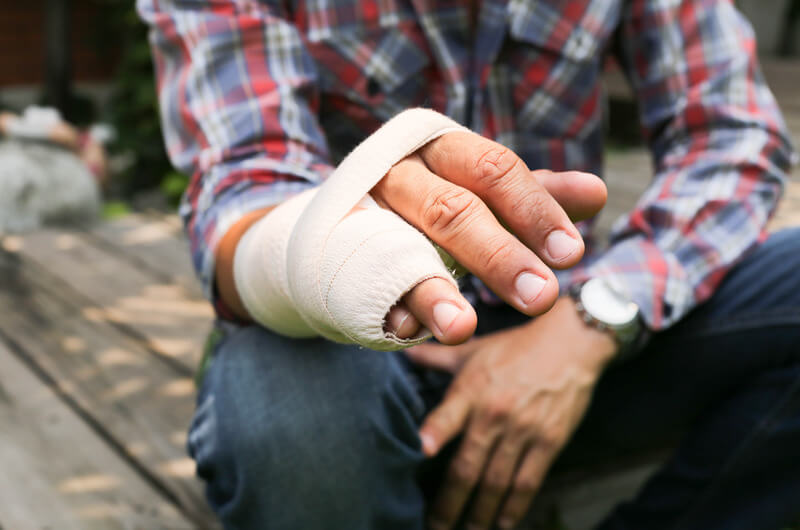Hire The Best Burn Injury Attorneys in New Mexico
"I highly recommend the law-firm of Tawney, Acosta & Chaparro P.C. to anybody in need of injury and/or employment legal representation." — Irene M.
Suffering a severe burn injury is a traumatic experience for victims, whether it was on the job, due to a defective product, or in some other accident. At Tawney, Acosta & Chaparro P.C., our New Mexico burn injury attorneys know the physical and emotional cost of these injuries.
Our firm has experience going to trial for severe burn injuries, and we understand what is at stake for victims and their families. That’s why we are committed to fighting for the rights of burn injury victims across New Mexico.

We Want to Hear Your Story – and We Want to Help
The Different Types of Burn Injuries
Burn injuries happen in various ways, each with a set of causes, complications, and treatments. Understanding the type of burn injury and its usual treatment and prognosis is crucial in pursuing a legal claim. Here are some of the most common types of burn injuries victims receive.
Thermal Burns
Thermal burns occur when exposed to external heat sources that raise the temperature of the skin and tissues, causing cell death or charring. These burns result from several different sources, including:
- Flames—direct exposure to flames is a common cause of thermal burns, often occurring in house fires, auto accidents, or outdoor fires;
- Hot liquids or steam—called scalds, these burns are a frequent household injury, especially in children; and
- Hot metals, glass, or other objects—contact burns from touching hot surfaces, such as stoves, irons, or industrial machinery, are often severe.
These types of burns are some of the most common. However, they range in severity. Most thermal burns in a household setting are surface-level.
Chemical Burns
Chemical burns occur when an irritant, such as an acidic or alkaline substance, contacts the skin or eyes. These burns cause damage not only on the surface but also in the deeper tissues, depending on the chemical concentration and the duration of exposure. Both household and industrial chemicals are potential causes of chemical burns.
Electrical Burns
Electrical burns result from the passage of electrical current through the body, causing rapid injury. These burns are deceptive, as the external damage may appear minimal compared to the potential internal injuries. Generally, electrical burns are caused by:
- Direct contact with electrical sources—this includes touching live wires, electrical outlets, or lightning strikes;
- Arcs—caused by electrical arcs that jump from high-voltage areas to the body, often resulting in severe burns; and
- Flashes—occur when electrical energy causes an explosion or flash, burning the skin without direct contact.
Typically, electrical burns present a more immediate danger and require prompt medical attention, which is especially true if the victim loses consciousness.
A Breakdown of Burn Degrees
Medical professionals classify burn injuries by their severity, from first-degree to fourth-degree burns. Each degree indicates a different level of damage to the skin and underlying tissues. The higher the degree, the more damage the burn causes to the area affected.
Fourth-Degree
Fourth-degree burns are the most severe, extending beyond the skin into muscles, ligaments, tendons, nerves, blood vessels, and bones. The affected area is either blackened or appears dry and leathery. Additionally, there may be a complete loss of sensation due to extensive nerve damage. These burns don’t heal on their own and require extensive medical intervention. The intervention ranges from life-saving measures and infection prevention to reconstructive surgery or amputation.
Third-Degree
Third-degree burns penetrate the thickness of the skin, destroying both the epidermis and dermis. The burn site can appear white, brown, or charred, and the area may feel numb due to nerve destruction. Despite the severity, there might be less pain initially because of nerve damage. These burns do not heal well and typically require surgical intervention, such as skin grafting. Recovery is a lengthy process and often results in significant scarring and loss of function.
Second-Degree
Second-degree burns affect the epidermis and the dermis (the second layer of skin), causing more extensive damage. These burns lead to intense redness, swelling, and blistering. The blisters may pop and leak fluid, making the skin appear wet. Pain can be severe due to nerve injury in the dermis. Healing time varies from two to six weeks, depending on the burn’s severity and care. Proper wound care is crucial to prevent infection and minimize scarring. However, some second-degree burns may require skin grafting.
First-Degree
First-degree burns are the least severe, affecting only the epidermis, also known as the outer layer of the skin. These burns typically cause redness, minor inflammation, and pain. Generally, the skin is tender to the touch but does not blister. First-degree burns usually heal within 7 to 10 days without scarring as the skin cells regenerate from the damage. Additionally, treatment is simple, involving cool water, soothing lotions, and over-the-counter pain relief.

The Four Elements of Establishing Negligence in a Burn Injury Claim
To prove negligence in a burn injury case, the plaintiff must demonstrate the following four elements:
- Duty of care. The defendant has a legal obligation to act in a certain way toward the plaintiff. In burn injury cases, this could mean an employer’s duty to provide a safe working environment, a manufacturer’s duty to produce safe products, or a property owner’s duty to maintain safe premises.
- Breach of duty. The defendant failed to meet their duty of care. This breach may be an action they took that was unsafe or their failure to undertake an action that would have prevented harm.
- Causation. The defendant’s breach of duty directly caused the plaintiff’s injuries. For this element, the plaintiff must show that their burn injury would not have occurred but for the defendant’s negligence.
- Damages. The plaintiff suffered actual damages as a result of the breach. Here, the plaintiff must sustain some form of loss, which may be physical, emotional, or financial.
Proving all of these aspects of negligence is challenging. It requires various forms of evidence that are difficult to obtain. However, our New Mexico burn injury lawyers know what types of evidence to look for and what expert witnesses to consult for a burn injury claim.
Potential Damages After a Burn Injury
In burn injury cases, victims may seek various damages, compensating for financial and personal losses. The law divides these damages into two categories: economic and noneconomic.
Economic damages are the out-of-pocket expenses you incur. In other words, they have a tangible financial value measured with estimates, receipts, quotes, etc. They usually include things like:
- Lost wages,
- Medical expenses,
- Loss of earning capacity, and
- Rehabilitation costs.
In contrast, noneconomic damages are your intangible losses after a burn injury. In other words, they aren’t usually measured in financial terms and are subjective. Some examples include:
- Pain and suffering,
- Loss of enjoyment of life,
- Loss of consortium,
- Emotional distress, and
- Severe disfigurement.
While measuring these damages is very personal, our experienced burn injury attorneys understand the long-term effect they can have on victims’ lives. Generally, they vary widely on a case-by-case basis.
Speak to a Skilled New Mexico Burn Injury Attorney
Our legal team is here to help you with your case.
The Burn Injury Attorneys at Tawney, Acosta & Chaparro P.C. Are Here to Help
If you or a loved one has suffered a burn injury due to someone else’s negligence, Tawney, Acosta & Chaparro P.C. is here to help. Our New Mexico burn injury attorneys understand the complexities of these cases and provide compassionate, effective representation.
With a track record of success and industry recognition by Super Lawyers and The National Advocates, we always give our clients the individual attention and care they need. Contact us today for a free consultation, and let us help you on your journey to recovery and justice.





